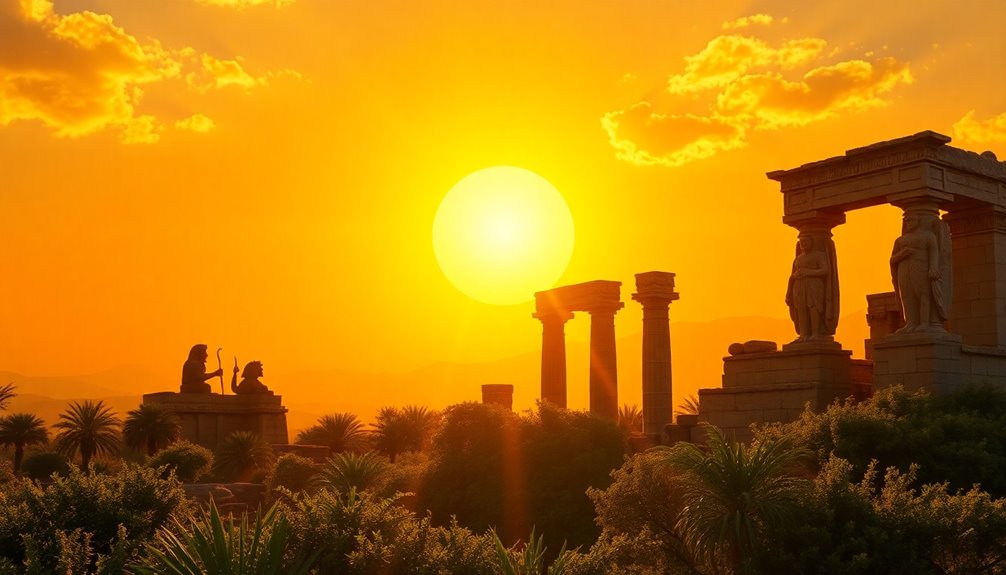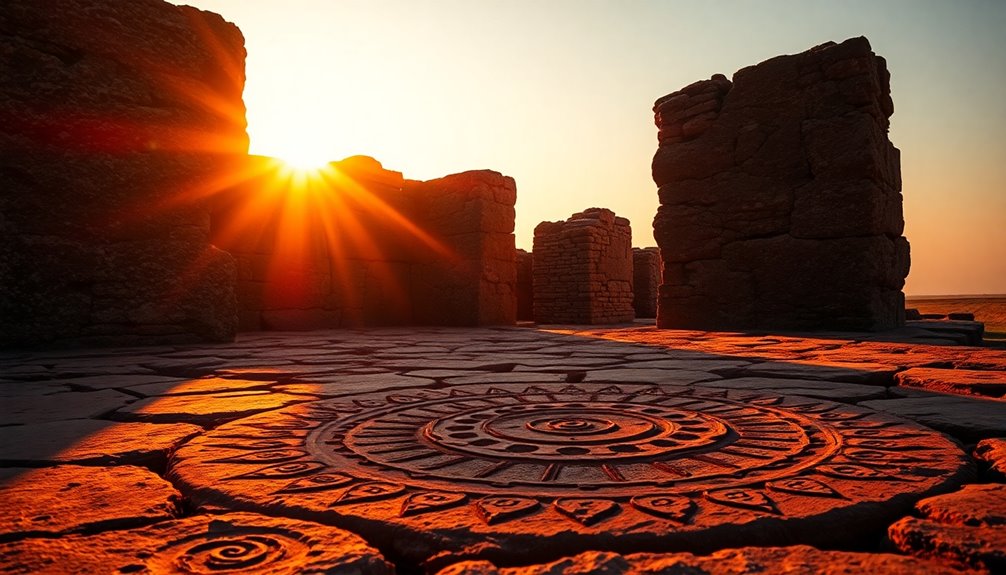The sun is a powerful symbol of life, energy, and hope in many cultures, reminding you of its essential role in our lives. It often represents growth, warmth, and enlightenment. In ancient myths, the sun is linked to gods of creation, like Ra in Egypt and Inti in the Inca civilization. People celebrate the sun through festivals during solstices and equinoxes, honoring its significance. Artists have painted it with bright colors to show joy and optimism. In spiritual beliefs, the sun signifies guidance and personal transformation. If you're curious, there's so much more to explore about the sun's amazing symbolism!
Key Takeaways
- The sun symbolizes life and energy, representing creation and vitality across various cultures and spiritual traditions.
- It is often associated with enlightenment, knowledge, and personal transformation in spiritual practices.
- Solar deities, like Ra and Amaterasu, embody the sun's importance in ancient myths and agricultural societies.
- The sun's circular disk design reflects the passage of time and the cyclical nature of life and seasons.
- Celebrations of solar events, such as solstices, highlight the sun's cultural significance and its role in community rituals.
Overview of Sun Symbolism

Throughout history, the sun has been a powerful symbol of life and energy, resonating with cultures worldwide. When you think about it, the sun gives us light and warmth, which are crucial for our existence. Many ancient myths even personify the sun as a god, linking it to creation stories and important agricultural cycles. These cultures celebrated solar events like solstices and equinoxes with special rituals.
You'll notice the sun's circular disk is a common symbol, often depicted with rays shining outwards. This design represents its life-giving qualities and connection to time. In art and literature, solar symbolism shines brightly, reflecting themes of knowledge and enlightenment. It also highlights the cycle of life, often contrasting the sun with the moon, which represents intuition and nurturing.
In alchemy, the sun is linked to gold, symbolizing perfection and the ultimate goal of transformation. You might even see sun imagery in modern flags and emblems, showing its lasting influence.
The sun truly embodies energy and liveliness, connecting us all through its radiant power. So next time you see a sunny day, remember the rich symbolism behind this magnificent star!
Astronomical Importance of the Sun

At the heart of our solar system lies the sun, a colossal star that plays an essential role in sustaining life on Earth. This massive ball of gas accounts for about 99.86% of our solar system's total mass! Can you imagine that?
Made up mainly of hydrogen and helium, the sun generates energy through nuclear fusion in its core. This energy is what keeps our planet warm and lively.
The sun's surface temperature is around 5,500 degrees Celsius, affecting our climate and weather patterns. Solar activity, like sunspots and solar flares, can even influence communication technologies here on Earth. With a diameter of about 1.4 million kilometers, the sun is truly a giant!
Throughout its life, the sun goes through exciting changes. It starts as a main sequence star, then becomes a red giant, and eventually, it will become a white dwarf.
The ancient concept of the solar cross often symbolizes the sun's power, while many cultures viewed the sun as a Sun god, representing life and energy. Understanding the sun's astronomical importance helps you appreciate the wonders it brings to our world!
Cultural Representations of the Sun

When you think about the sun, it's amazing to see how different cultures celebrate it!
From the powerful Egyptian god Ra to the vibrant Zia symbol representing the seasons, the sun's warmth and light inspire countless stories and traditions.
Let's explore how myths and worship practices show just how important the sun is in shaping our world.
Cultural Worship Practices
Across the globe, cultures have looked to the sun not just as a celestial body, but as a powerful symbol imbued with divine significance. Many ancient cultures worshiped the sun as a deity. For example, in Japan, Ama-terasu no Oho-kami is a sun goddess, and emperors were seen as Sons of the Sun.
In ancient Egypt, the sun was represented by Ra, a god symbolizing life and creation. They often created beautiful art and held rituals to celebrate solar cycles.
The Romans even built temples with an oculus that aligned with the sun's path, letting sunlight shine through during equinoxes. This clever design showed how the sun marked time and seasons.
Festivals dedicated to solar deities often happen during solstices and equinoxes. These celebrations connect to the four seasons and honor the sun's role in agriculture and fertility.
Indigenous American cultures also recognize the sun as an essential life force, leading them to hold ceremonies that honor its importance in nature and the cosmos. These worship practices show how deeply people appreciate the sun and its life-giving power.
Myths and Legends
Cultural worship practices reflect a deep reverence for the sun, which often finds expression in myths and legends that shape societies' understanding of this powerful celestial body. Different cultures have their unique stories about the sun, filled with excitement and wonder.
For example, in ancient Egypt, the sun god Ra traveled across the sky in a solar barque, symbolizing creation and life cycles. The Inca people celebrated Inti, their sun god, with the vibrant Inti Raymi festival, honoring his warmth that nurtured crops. In Japan, the sun goddess Amaterasu is seen as the ancestor of the imperial line, representing light and fertility. The Greeks adored Helios, who drove his chariot across the sky, marking the passage of time.
Native American tribes like the Zuni view the sun as a life-giving force, essential to their traditions. The Zia Sun symbol and the idea of Sol Invictus also highlight the sun's significance in various cultures.
Here's a quick look at some sun myths:
| Culture | Sun Deity |
|---|---|
| Ancient Egypt | Ra |
| Inca | Inti |
| Japan | Amaterasu |
| Greece | Helios |
Mythological Significance Across Civilizations

The sun's mythological significance resonates deeply in various civilizations, revealing humanity's intrinsic connection to this celestial body. In ancient Egypt, the sun was worshiped as the god Ra. He represented creation and journeyed across the sky in a solar boat, symbolizing life and rebirth.
Meanwhile, the Zia Indians of New Mexico hold the sun sacred, using its symbol—a red circle with four rays—to embody the four cardinal directions and the seasons.
In Japan, the sun goddess Amaterasu is a key figure in Shinto belief. She brought light to the world and is tied to the imperial family, showing the sun's importance in their identity.
The Inca civilization also revered Inti, the sun god, who was seen as an ancestor and played a vital role in agriculture. Celebrations like Inti Raymi highlight this reverence.
Additionally, in ancient Greece, Helios drove a chariot across the sky, symbolizing the sun's energy and its role in agriculture and timekeeping.
Each of these stories shows how the sun connects people through culture, tradition, and shared beliefs, making it a powerful symbol in our lives.
Scientific Insights Into Solar Influence

Did you know the sun is more than just a bright ball in the sky?
Its rays affect our climate and weather, helping plants grow and keeping our ecosystems balanced.
Let's explore how solar radiation shapes our world and why understanding its influence is so important!
Solar Radiation Effects
Solar radiation plays an essential role in various processes that sustain life on Earth and shape our environment. When the Sun appears in the sky, it brings energy that fuels photosynthesis, allowing plants to turn sunlight into food. This process supports entire ecosystems, from tiny insects to large animals, creating a balance in nature.
The Sun emits a broad spectrum of radiation, including ultraviolet (UV) rays. While these rays can cause skin damage, they also help our bodies produce vitamin D, which is critical for our health. Isn't that amazing?
Solar radiation also influences weather patterns and seasonal changes. As the intensity of the Sun changes, so do temperatures and precipitation levels. You might notice how summer feels different from winter, and that's partly due to these solar effects.
Additionally, technology has advanced to harness solar energy as a renewable resource, which can help reduce harmful greenhouse gases. By using solar power, we can combat climate change and protect our planet.
Climate Influence Studies
Understanding how solar radiation impacts climate systems is key to grasping the broader implications of climate influence studies. The sun, often depicted as a rayed solar symbol, plays a crucial role in shaping our planet's weather and climate. Let's explore how.
| Aspect of Solar Influence | Description | Impact on Climate |
|---|---|---|
| Solar Energy | Drives temperature and weather patterns | Influences seasonal changes |
| Photosynthesis | Plants convert sunlight into energy | Forms the basis of food chains |
| Solar Cycles | Approximately 11-year cycles of solar output | Affects historical climate events |
| Climate Models | Incorporate solar data for predictions | Help understand climate trends |
Solar energy fuels photosynthesis, supporting ecosystems. Variations in solar output, like during the Little Ice Age, show how changes can alter our climate. Climate influence studies use solar activity data in models to predict future changes. Researchers even explore solar radiation management to reflect sunlight, aiming to mitigate climate change effects.
Artistic Depictions of the Sun

Throughout history, artists have often turned to the sun as a powerful symbol in their work. You can see its vibrant energy captured in many forms, like the rayed circular disk that represents life itself. Different cultures put their spin on this basic shape, adding triangles or wavy lines to express new meanings.
For example, the ancient Egyptian sun god Aten was depicted as a disk with rays ending in hands, showcasing how the sun nurtures and supports life.
One famous example is the Star of Vergina, a symbol from ancient Macedonia. It features a sun with multiple triangular rays, symbolizing royalty and divinity in Greek culture. Today, sun symbols continue to shine bright in modern flags and emblems, like those of Uruguay and New Mexico, reminding us of their deep-rooted significance.
Also, think about the Inca sun god Inti and the Aztec solar deity Tonatiuh, both beautifully illustrated with intricate designs that highlight their cultural importance.
These artistic representations show how the sun remains an essential, inspiring figure across time and cultures, inviting you to explore its warmth and energy!
Solar Symbols in Ancient Writing

Ancient writing often reflects the deep significance of the sun across various cultures. You might find it fascinating that in Egyptian hieroglyphs, the sun is represented by a circular solar disk, known as Gardiner N5. This symbol shows how important solar deities were to the Egyptians. Variants of this disk, sometimes with a central dot or the Uraeus, highlight the sun's powerful role in their mythology.
Moving to early Chinese writing, the sun was also shown with a central dot. Over time, this evolved into the square shape we recognize today. Isn't that cool?
In Greek art, the sun took on a symbol of a disk with rays, a common sight in manuscripts from the 12th century.
Don't forget about the Nebra sky disk, dating back to around 1600 BC. It features a solar disk among other celestial bodies, showcasing how ancient people understood astronomy. The sun wasn't just a source of light; it marked the four seasons and guided their lives.
Through these symbols, we see how cultures cherished the sun, connecting them across time and space!
Modern Interpretations and Usage

The sun's enduring significance continues to resonate in modern interpretations and usage across various fields. You can see its bright glow symbolizing hope, renewal, and positivity in art and literature. When you look at logos, especially in the solar energy industry, they often feature the sun, representing energy and a bright future.
In the table below, you can explore how the sun shines in different areas of our lives:
| Field | Symbolism |
|---|---|
| Art & Literature | Warmth and optimism |
| Branding | Energy, liveliness, and sustainability |
| Social Movements | Illumination and awareness |
Many spiritual practices today incorporate solar images, linking the sun to personal growth and self-discovery. You might also notice the sun in popular culture—like music, fashion, and design—where it represents freedom and a carefree spirit, especially during summer. So, whether it's the fourth day of the week or a sunny day outside, the sun's symbolism truly shines bright, reminding you of the joy and energy in life, like four wavy lines dancing in the wind! In fact, just as the ideal steeping time for Earl Grey tea enhances its flavor, the sun can enhance our experience of life by uplifting our spirits.
Spiritual Connections to the Sun

Sunlight has long been a powerful symbol in various spiritual traditions, representing enlightenment and divine energy. You can feel this connection in many cultures, where the sun is seen as a source of life and inspiration. For centuries BC, ancient societies worshiped solar deities like Ra and Helios, celebrating the sun's powerful influence.
Here are some key spiritual connections to the sun:
- In Christianity, the sun is linked with the cross symbol, representing Christ as the light of the world.
- The Zia symbol, from the Zia Indians, shows the sun's sacredness with its four rays, symbolizing directions, seasons, and life's duties.
- Festivals around solstices and equinoxes celebrate themes of rebirth and growth, showcasing our deep bond with the sun.
These connections remind us that the sun isn't just a physical light but a spiritual guide. Whether you're enjoying a sunny day or reflecting during a festival, you can feel the joy and hope the sun brings. Additionally, the sun's energy can be seen as a representation of aura colors that reflect our emotional states and spiritual growth.
It inspires you to embrace life, renewal, and the interconnectedness of all beings. So next time you see the sun, remember its powerful spiritual significance!
Frequently Asked Questions
What Does the Sun Symbolize?
The sun symbolizes many wonderful things! It represents life, energy, and warmth.
When you think of the sun, you might picture bright days that make you feel happy and alive. It also shows the cycle of time, like the changing seasons.
In stories and myths, the sun is often seen as a powerful figure, guiding us and bringing light.
What Is the Metaphor of the Sun?
Did you know that the sun is about 4.6 billion years old? Wow!
The metaphor of the sun shines bright in our lives. It represents warmth, hope, and new beginnings. When you think of the sun rising after a dark night, it reminds you that challenges can lead to brighter days.
The sun also symbolizes knowledge, lighting the way for your understanding. So, whenever you see the sun, remember its powerful message of positivity!
What Is the Poetic Meaning of the Sun?
The poetic meaning of the sun shines bright with joy and warmth!
When you think of the sun, you might imagine hope and new beginnings. Poets often use the sun to symbolize life and energy, showing how it brings happiness.
It can also represent clarity, guiding you through tough times.
Plus, the sun reminds you that life's moments, like sunlight, can be fleeting and beautiful, encouraging you to cherish every single day.
What Does Sun Symbolize in the Bible?
Imagine you're basking in the warm sunlight on a summer day—it feels so good!
In the Bible, the sun represents God's glory and light. It's like a divine spotlight shining on you, offering guidance and hope.
When you read about the "Sun of Righteousness," it's all about healing and goodness.
Plus, the sun shows God's faithfulness, reminding you that light always overcomes darkness.
Isn't that a comforting thought?
Conclusion
So, the sun isn't just a big ball of fire in the sky; it's a powerful symbol with deep meanings! From ancient myths to modern art, its bright rays inspire us in so many ways. Just like how your favorite superhero might have a glowing shield, the sun serves as a shield of warmth and life. Whether you're soaking up its rays or marveling at its beauty, remember that the sun connects us all, shining brightly in our hearts!











